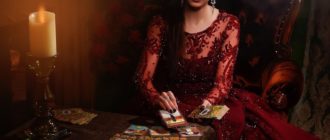This article describes the best and most famous paintings by Leonardo da Vinci.
Contents
- Leonardo da Vinci “Lady with Ekhnosty” is a famous picture of a woman: a description briefly with a photo
- "Madonna Litta" - the first picture of Leonardo da Vinci: Characteristic
- “Christ is the Savior of the World” - the best picture of the Italian artist Leonardo da Vinci: original, description
- Famous painting “Secret Evetere” Leonardo da Vinci: Characteristic
- The most famous and best picture of the Italian artist Leonardo da Vinci "Jaconda" is a portrait of Mona Lisa: Characteristic
- "Vitruvian man" is the famous picture of the artist Leonardo da Vinci: Description
- "Madonna with cloves": Description of the famous picture of the Italian artist Leonardo da Vinci
- "Annunciation" is one of the very first paintings of the Italian artist Leonardo da Vinci: Characteristic
- "Baptism of Christ" is another of the first paintings of the artist Leonardo da Vinci: Description
- "Madonna Benois": Description of the picture of the artist Leonardo da Vinci
- "Worship of the Magi": a description of the unfinished picture of the artist Leonardo da Vinci
- "Saint Jerome in the Desert": Description of the picture of the artist Leonardo da Vinci
- “Madonna in the rocks” is a famous picture of the Italian artist Leonardo da Vinci: Description
- "Portrait of the musician": Description of the picture of the Italian artist Leonardo da Vinci
- "Beautiful Ferroner": Description of the picture of the artist Leonardo da Vinci
- “St. Anna with Madonna and Baby”: Description of the picture of the artist Leonardo da Vinci
- "John the Baptist": characteristics of the picture Leonardo da Vinci
- How much is one picture of Leonardo da Vinci?
- Video: 5 secrets of the famous paintings by Leonardo da Vinci!
U Leonardo da Vinci A lot of written works. All of them cannot be characterized. Study the biography of this great author in the article on this linkAnd find out the secrets of his most famous works.
Below you will find descriptions of some works of this great artist. These are really masterpieces that are worthy of special attention. Millions of people heard about such famous paintings, and only a few saw them in the original. Therefore, let's get involved in culture and study the work of this worthy author. Read further.
Leonardo da Vinci “Lady with Ekhnosty” is a famous picture of a woman: a description briefly with a photo
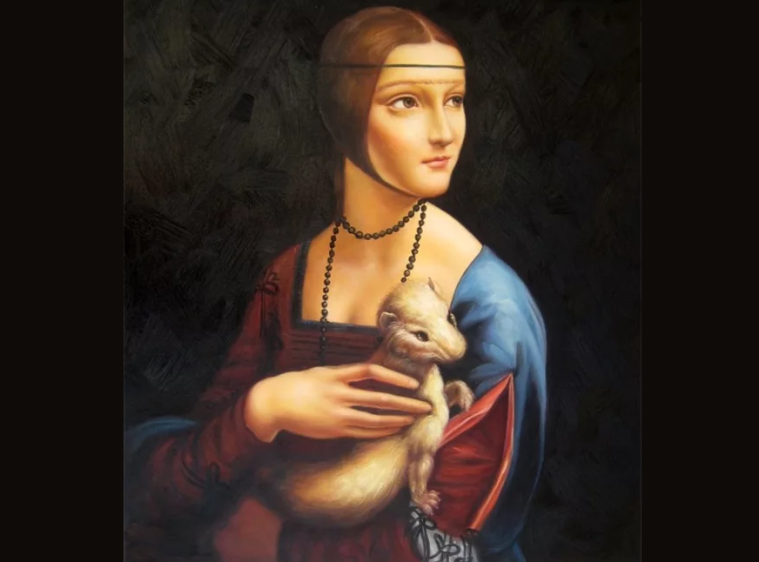
"A lady with an ermine" - The famous picture of a woman. Here is its brief description:
- One of the best paintings by the artist, despite the fact that authorship was questioned.
- Paints and shades are selected successfully.
- It affects anatomicality.
- On the canvas, a woman is depicted by a half -worn, on whose hands the animal sits.
- His skin is snow-white, it exudes aristocracy and luxury.
It seems that by ermine Leonardo da Vinci shows the immaculateness of the girl herself. After all, the animal will die rather than staining himself.
"Madonna Litta" - the first picture of Leonardo da Vinci: Characteristic
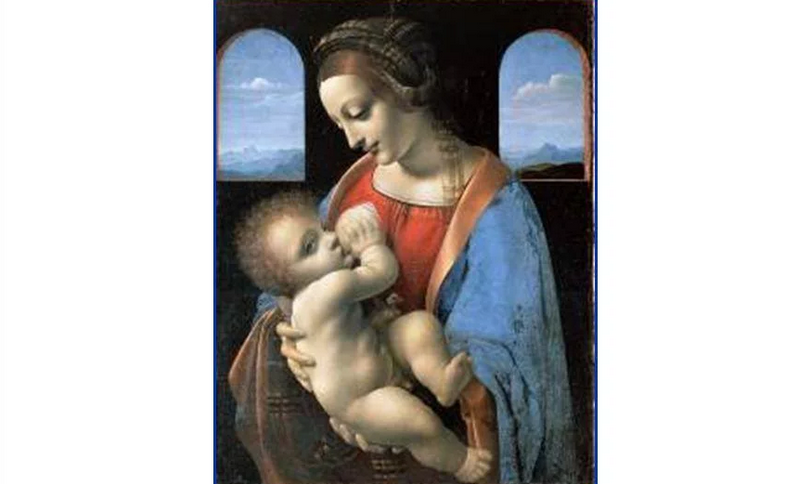
The author is attentive to details. Suppose red vestment has cuts for feeding the baby. One of them is sewn. This probably suggests that breastfeeding will stop soon, the baby grows up. This is also evidenced by curls on the baby's head. The latter is already confidently holding on his mother’s breast and eagerly drinks milk. It can be seen that in his handles and legs there is already enough strength. It is likely that it is already strong enough to walk independently. Characterization of the first picture Leonardo da Vinci "Madonna Litta":
- The woman is depicted against the background of two arched openings through which mountains and sky are visible. However, the lighting functions are not observed.
- A dim light source is available on the left side and falls on the girl. A similar technique was used in the "Secret evening".
- It is noteworthy that the faces of the heroes are painted perfectly - but small details, such as say, the girl’s cloak, are written in rude strokes.
- Despite the fact that the artists of that time usually worked carefully on each fold, Leonardo da Vinci did not pay attention to this.
- Perhaps something prevented Leonardo from completing work. Or he simply did not have enough patience.
It is worth noting that various studies of details are a successful way to place accents and show the viewer that the main thing is the main thing and what is secondary.
“Christ is the Savior of the World” - the best picture of the Italian artist Leonardo da Vinci: original, description
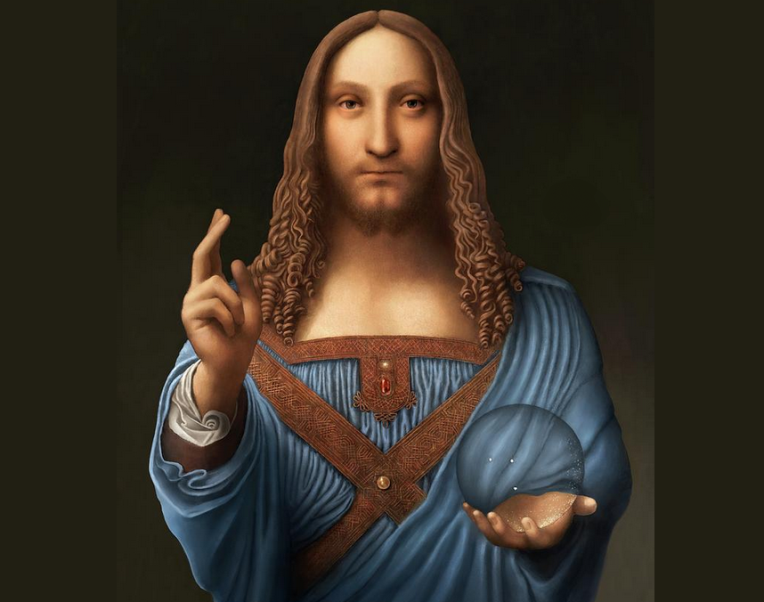
One of the best paintings. This original Italian artist Leonardo da Vinci entitled "Christ is the Savior of the world" Fascinates everyone who sees it. Here's a description:
- In the understanding of the Creator, Jesus is somewhat atypical.
- He appears with a ball, in blue vestments.
- The eyes of a young man seemed to look not at the viewer, but somewhere through him.
- The face is spiritualized, as if on the icon.
- Christ is pretty, he is careful, and also looks nowhere. The Savior's eyes seemed to be removed from the world.
- He is only in himself understandable thoughts.
I want to contemplate the picture humbly and calmly, looking for the smallest details, and enjoying them.
Famous painting “Secret Evetere” Leonardo da Vinci: Characteristic

Also refers to the famous paintings of the author. But it is considered an unsuccessful experiment. Why? Here is a characteristic of a famous picture "Secret evening" by Leonardo da Vinci:
- In the end 15th century The duke ordered the artist to paint the wall of the monastery for a huge amount.
- It was necessary to paint on raw plaster, after that polishing.
- However, Leonardo approached the fresco with the characteristic of Renaissance, a scope, ignored the restrictions.
- It is noteworthy that the people who served in the monastery at first wanted to saw off Christ's legs (excellent contradiction to their own beliefs), because there should have been a door.
- And after that, the unwashed artists, restoring the fresco, ruined her plot.
At the head of the table sits Christ With their apostles. There is and Judas - It was the one whom Da Vinci wrote off from a drunken young man whom he found in the ditch. Despite the fact that the fresco was very injured from time and numerous ups and downs, she, as before, exudes monumentality and reverence.
The most famous and best picture of the Italian artist Leonardo da Vinci "Jaconda" is a portrait of Mona Lisa: Characteristic
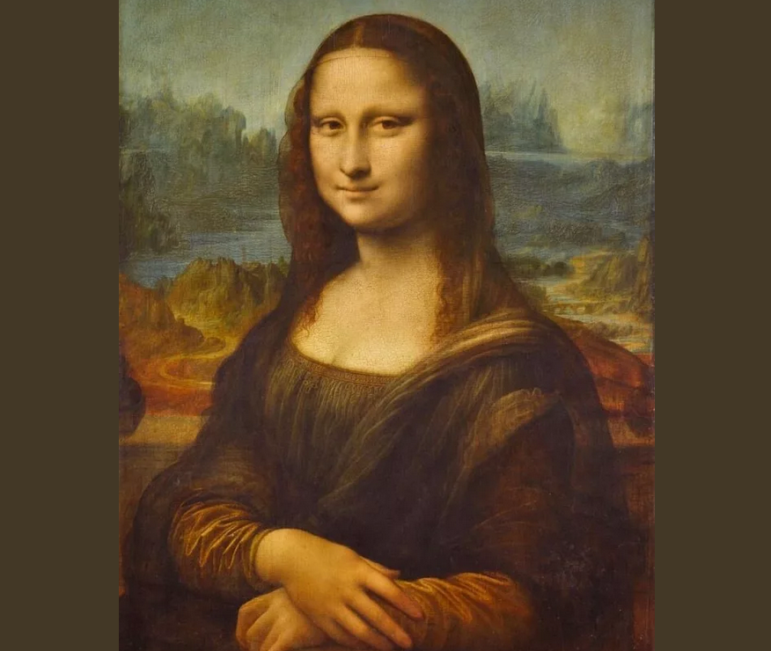
The secret of the smile of the heroine of the portrait Mona Lisa Until now, no one has unraveled. And some believe that in this best and famous picture of the Italian artist Leonardo da Vinci And there is no smile at all. Here is the characteristic of the work "Jaconde":
- It is believed that this pretty woman is either the wife of Del Jocondo - a merchant, or the same model who posed for "Ladies with an ermine".
- Some experts believe that Monu Lisa was portrayed by a student of the artist.
- Dress y JaConds An incomprehensible color, apparently, Da Vinci experimented with paints. Therefore, it is not known what color the sleeves were initially. However, the picture is filled with color and charm.
- Arms JaConds Street folded. It seems that she looks appraisingly at the viewer from the picture, showing with all her appearance that no one has the right to argue with her reputation.
By the way, the very vestments of the heroine of the picture and her pose say that the depicted lady belongs far from the poor estate and holds it accordingly.
"Vitruvian man" is the famous picture of the artist Leonardo da Vinci: Description
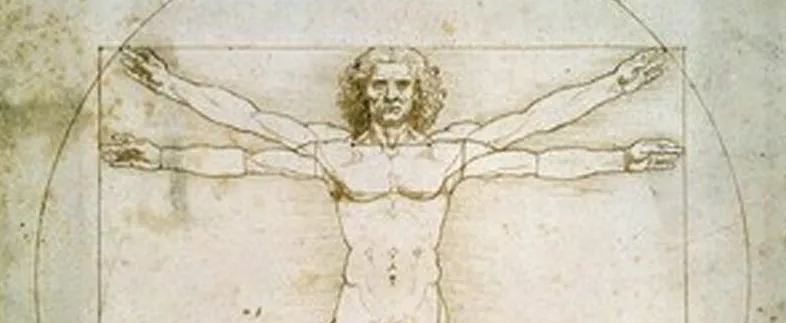
This interesting work is made of these materials:
- Paper
- Feather
- Ink
- Watercolor
Here is a description of the famous picture of the artist Leonardo da Vinci "Vitruvian man":
- This is not just a display of a man’s figure.
- This image is an explanation for such a phenomenon as symmetry.
- This is a "golden section" or "divine proportion" where there are 6 palms and one elbow, and the length from the tip of the longest to the lowest base - 1 palm.
- In this case, growth is equal to the scale of the hand.
- 24 palms Together with four elbows, human growth can be shown.
Accordingly, this creation more exudes cultural heritage and is rationalization work, and not just a work of art.
"Madonna with cloves": Description of the famous picture of the Italian artist Leonardo da Vinci

"Madonna with cloves" - This is oil painting on the board. It is believed that the Italian artist Leonardo da Vinci He wrote it when he served as an apprentice at Verrokrko. Detailization of the picture speaks for itself. Here is a detailed description:
- The light is soft and diffused.
- Nevertheless, the years did not regret the canvas, and the restoration was inept, therefore irregularities formed.
- A sitting woman holds a clove in one hand, which a child sitting on her knees wants to grab.
- It is possible that the flower symbolizes such a Christian virtue as the good and the ability to see the beauty of human thoughts.
- It is these thoughts that mother wants to convey to her “special child”.
It is believed that da Vinci created this work, while still a student of the great master at that time. However, in its magnificent composition, the selection of colors and images, it is not inferior to it later and eminent work.
"Annunciation" is one of the very first paintings of the Italian artist Leonardo da Vinci: Characteristic

The sign picture with which the artist’s work has been revealed to the world is "Annunciation". This is one of the very first works of an Italian artist Leonardo da Vinci. Here is the characteristic:
- It is believed that it was created in conjunction with Verrrokoo himself, with whom da Vinci studied, starting with 14 years.
- Anatomical accuracy prevails, and also affect the nature of the strokes and the composition of the colors.
- The admixture of lead is felt, which is atypical for Leonardo.
- The picture depicts the Virgin Mary and the Archangel Gabriel appeared to her.
- The latter bowed to the Mother of God in reverence.
- She magnificently sits on the contrary, welcoming the archangel. It seems to be ready to give him further instructions or to listen to his speech.
The characters are drawn incredibly realistically - as if real people before the audience.
"Baptism of Christ" is another of the first paintings of the artist Leonardo da Vinci: Description
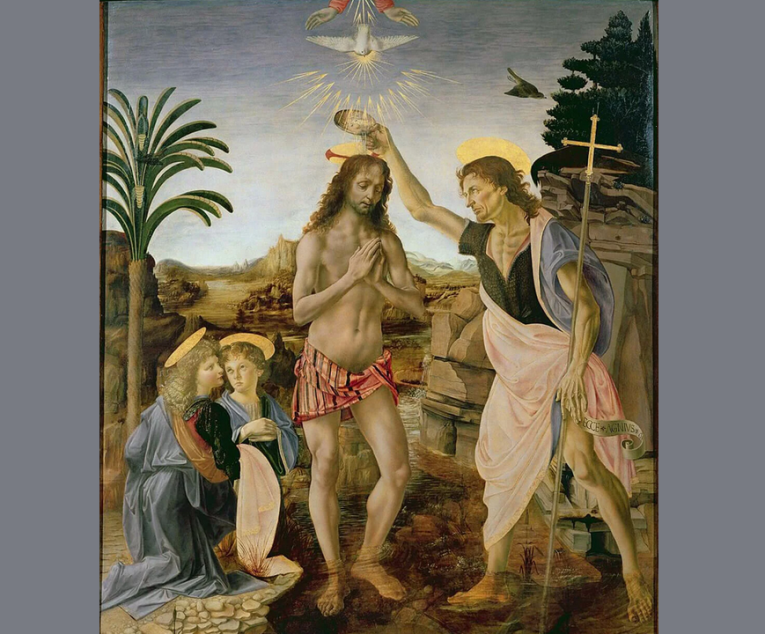
Work "Baptism of Christ" was made in co -authorship with the teacher. This is another of the first paintings of the artist Leonardo da Vinci. Here is a description of the work "Baptism of Christ":
- An angel with blond hair in the left corner is depicted on the canvas.
- Da Vinci was then 24 years. There is an opinion that Verrorokrkoo was so amazed at the work of a young student that he stopped drawing himself, being shamed.
- It is known that the teacher painted Jesus and the Baptist, and Da Vinci himself only angels and the surrounding landscape.
- The canvas turned out to be really monumental, impressive.
- The central character for artists is Jesus Christ. It is in the foreground.
- On right - John the Baptist With a staff and thicket. He produces the rite.
- The picture depicts two angels, kneeling. These are witnesses of the Sacrament, who are slowly talking.
It is quite obvious that their conversation concerns those events that may begin after the case of the Baptist is completed. Nature is quiet and solemn. The waters of Jordan splash in the distance. Open palms are located in the sky, as if the pigeon is inflated from them. In fact, the palms themselves are a God-father, and the pigeon is nothing more than the Holy Spirit.
- Here there is a trinity of divine nature. The picture completely conveys the atmosphere of the sacrament.
- It seems that the viewer can feel like an invisible witness of what is happening, hear every word, see every action.
- The legs of Jesus in the water - he humbly passes the rite of washing.
- The miraculous, mystical light over his head makes us think that this baptism means much more than the same ordinary, ordinary Christian.
- Da Vinci seems to show the process of exchange of divine energy between the Son of God and His subjects.
It seems that Christ during the procedure seems to be filled with magical energy, which he will subsequently give people, endlessly loving and wanting to atone for sins.
"Madonna Benois": Description of the picture of the artist Leonardo da Vinci
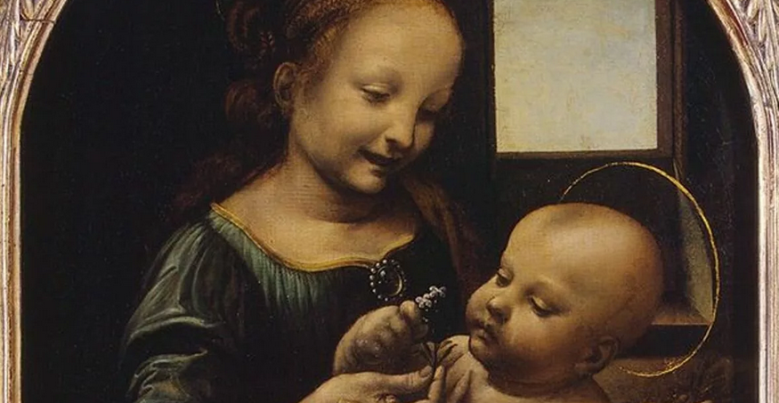
Picture of the artist Leonardo da Vinci "Madonna Benoit" It is called a ghost of an old woman with a wrinkled neck. The authorship was established with the help of a famous art critic. It was hired by the Benoit family itself in order to establish who is a genuine author. What is especially striking is a cruciferous plant. It hints at the fate of the child. But neither the mother nor the child think about it. Here's a description of the work:
- Judging by the expression, the woman is depicted at the time of the game with her child. Her face exudes fun and carefree.
- As for the child, he is not serious for years and as if stretching, looking for something.
- Maria is dressed in fashion that existed at that time in Florence. Despite the fact that the picture is painted with the model, her facial features are far from perfect.
- The girl shows the child a flower, and he tries to explore it better.
- He holds his mother's hand so that she does not remove a new toy from him.
- The core itself symbolizes the crucifix.
- Positions and gestures are natural - even a light -air environment can be tied.
Both figures are quite closely inscribed in the canvas, and occupy almost all of its space. There is not so much space around a woman with a child in which any interesting and important details could be entered. Accordingly, it is the central images that attract all attention, that are fundamental.
"Worship of the Magi": a description of the unfinished picture of the artist Leonardo da Vinci
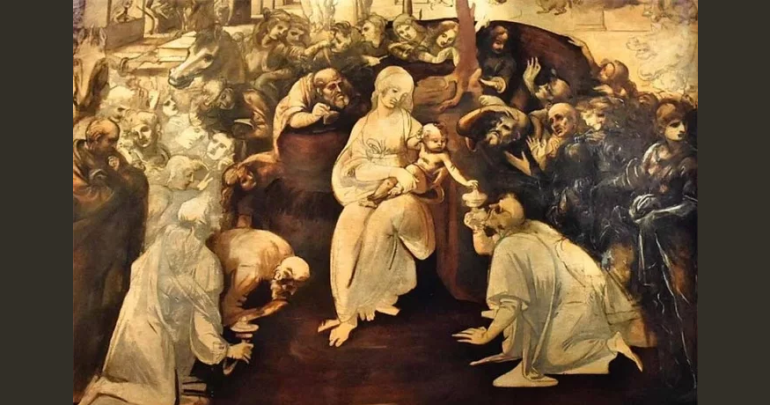
This picture of the genius remained incomplete. At that time an artist Leonardo da Vinci He left for Milan and did not want to return. But customers kept the canvas as a memory. It is filled with meaning, composition and symbolic meanings. Description of an unfinished picture "Worship of the Magi":
- Palma seems to be a sign of Jerusalem.
- The ruins of the temple on the horizon are a sign of paganism that has already outlived itself, which has already replaced the Christian faith.
- The center depicts Madonna with a baby.
- The Magi were humbly bowed to God's son, future Messiah and the Savior of people.
The picture is striking in its scale and riot of colors, as well as incredible realism.
"Saint Jerome in the Desert": Description of the picture of the artist Leonardo da Vinci
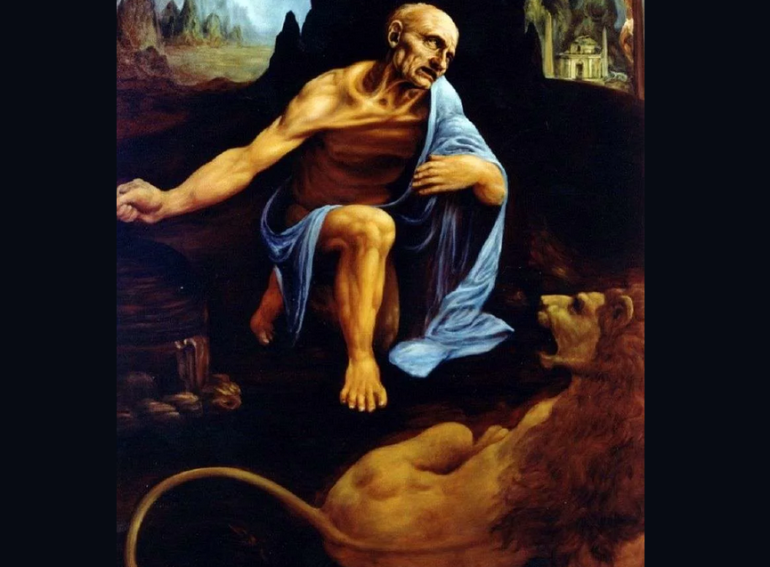
The accuracy with which Leonardo da Vinci depicts the human body in the painting "Holy Jerome in the Desert" is striking. The work has a difficult fate. It was cut, and the boards were used for bad purposes. They say that part of the picture was a lid for Laria. Here is a description of the work of a great artist:
- The tense face of Jerome and the swollen veins throughout his body give the impression that he soon rushes into battle not for life, but to death with a lion, which is depicted nearby.
- The latter is also in suspense and is preparing to jump.
- It is possible that this refers to the confrontation of the two faith - Christian and pagan.
- Of course, the first force symbolizes Jerome, and the second - the predator met him in the desert.
- But, despite the morale and a tense body, the old man looks dejected, as if internally he is already ready for his death.
It is difficult to say whether it was an author’s idea or is simply a minute philistine opinion. One way or another, the purity of drawing parts is simply amazing. Sometimes the image cannot really be distinguished from the photo.
“Madonna in the rocks” is a famous picture of the Italian artist Leonardo da Vinci: Description

Such works 2 - in Parisand London. They are almost the same. The first version was a sash in the altar to order. However Leonardo da Vinci He did not adhere to a clear script, he considered that he resorted to liberties above this. The work was not accepted immediately. Cyclamen near Jesus is a symbol of love. The primrose speaks of human benefactors, Acantus speaks of resurrection, and St. John's wort is a symbol of blood spilled for spiritual ideals, the suffering of martyrs.
This famous picture is as mysterious as the Italian artist Da Vinci himself. Here is a description of the work "Madonna in the rocks":
- Four figures are placed in such a way that the Virgin Mary is a peak.
- To her left, the cross from her reeds holds the baby John the Baptist.
- He also reaches out to another child. Perhaps this is himself JesusIn which John asks for blessings.
- Madonna seems to patronize him.
- Her blue color of clothing is combined with the mountains and blue sky, as well as with the robe of the angel that is nearby.
- The composition is voluminous, the chiaroscuro is well transmitted.
- It can be seen that the baby-Isus gave the necessary blessing to the Baptist.
- As for the angel, he is a silent observer.
- A shade of genuine happiness is captured on his face, and white wings are half folded, incredibly precisely drawn.
Da Vinci even managed to convey the curls of the angel that were lit up with light. They look like gold threads. The grotto itself is also quite interesting - bizarre rocks and white flowers on green grass. Mountains appear to the artist frightening. In fact, he is very afraid of sinister darkness, but still wants to check what is there, inside. This contrast between peace and danger makes the picture magnificent.
"Portrait of the musician": Description of the picture of the Italian artist Leonardo da Vinci
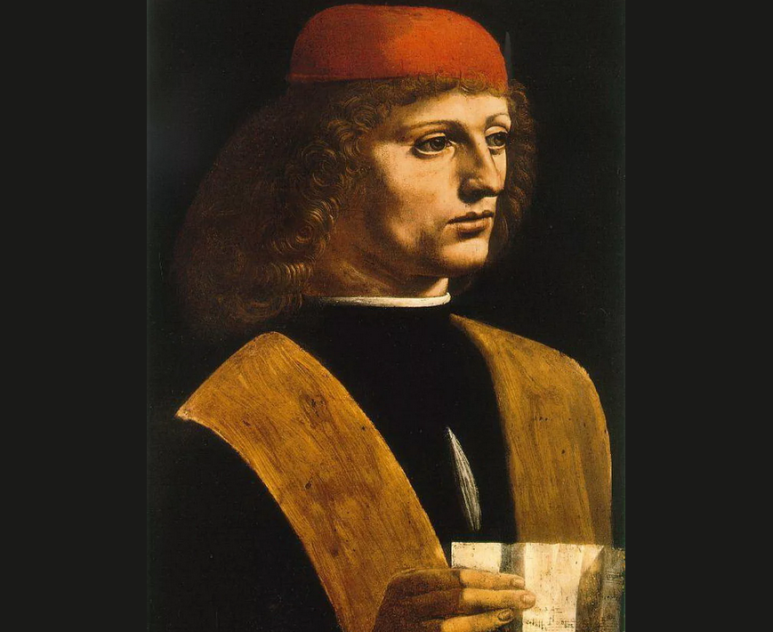
This is one of the few male portraits of the Italian artist Leonardo da Vinci. At first, art historians thought that the Milan nobleman was on the canvas, but the inscription on the scroll was “angelic song”. That is why it was concluded that this is a musician. The young man poses with a turn of three quarters. His face is filled with intelligence, quite spiritualized. It can be seen that the young man holds on with dignity. Here is a description of the picture "Portrait of a musician":
- The light is now replaced by a shadow, then flowing into golden, delicate shades.
- The artist masterfully conveys a thin face, a dimple on the chin.
- The filler's eyes are beautiful, bright. The eyelash line is thin and clear. He has long, curly, brown hair and a red cap.
- But the musician does not look at the viewer. His gaze is fixed somewhere inside himself.
- It is also worth noting that he has an unusual eye cut.
- Looking at the picture, I want to know what the hero thought about?
- Perhaps thousands of melodies are already hovering in his head.
- Subsequently, they will be woven into wonderful songs that will change the world for the better.
The picture is warm, pacified. It seems that a living person appeared in front of the viewer, which is a person with his dreams, thoughts, aspirations, sorrows, joys and a rich inner world.
"Beautiful Ferroner": Description of the picture of the artist Leonardo da Vinci
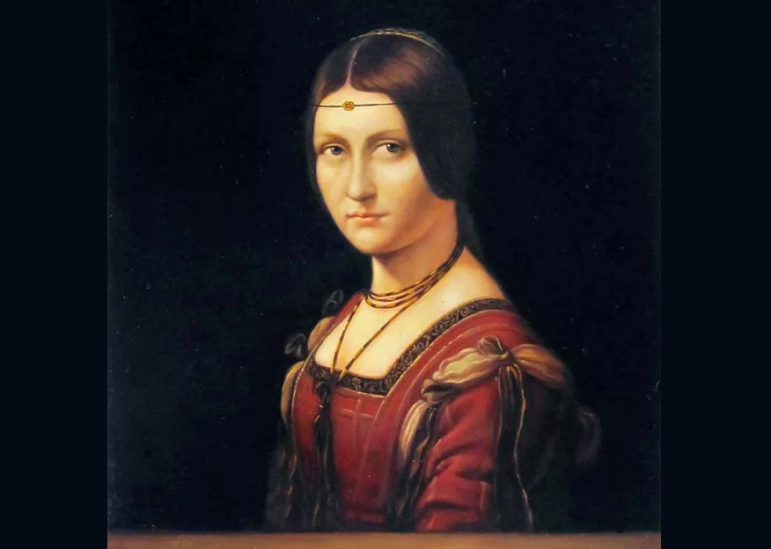
It is believed that the canvas depicts Lucretia Krielly, the mistress of the same duke who patronized the artist. Despite the name, the expression on the woman’s face is quite severe, even stressful. There is a contrast between perfectly executed features and hair, which are not drawn well enough. Perhaps Leonardo was inspired by Pliny the elders, who said that Apelles intentionally did not finish Venus of the Comskoye. However, this work was more successful than everyone else. Here is a description of the artist's picture Leonardo da Vinci "Beautiful Ferroner":
- Da Vinci, as before, plays with chiaroscuro and soft, as well as dark halftones.
- He appreciates the beauty of lines and relief modeling.
- It seems that a little more and a young woman in the picture will come to life - her beautiful eyes seem so inspired.
- Despite the dark background, the picture is bright. It is possible that this effect is achieved due to the incredible realism of the image.
- The girl's face is wary-as if she expects something. Although, quite possibly, the model was somewhat modest and behaved somewhat constrained in front of the artist. One way or another, the appearance of the main character exudes mystery.
- The heroine's eyes are wide open. They are very expressive and as if peering into someone. The woman behaves restrained and as if asking a dumb question. Her skin is incredibly delicate, velvety, there is a blush. The eyebrows are dark, and the lips are tightly compressed. A girlish face frames brown hair.
- A lace is tied from behind, on which there is a precious stone in a curly frame.
- By the way, it was precisely such pendants that were called ferroners. That is why the author called the picture so.
- The girl also has a necklace of beads (long and thin), very elegant and aristocratic.
It is difficult to say why the heroine da Vinci is in such bewilderment and what she is waiting for. One way or another, the majestic image hints that she is a serious, albeit young lady from a noble estate.
“St. Anna with Madonna and Baby”: Description of the picture of the artist Leonardo da Vinci
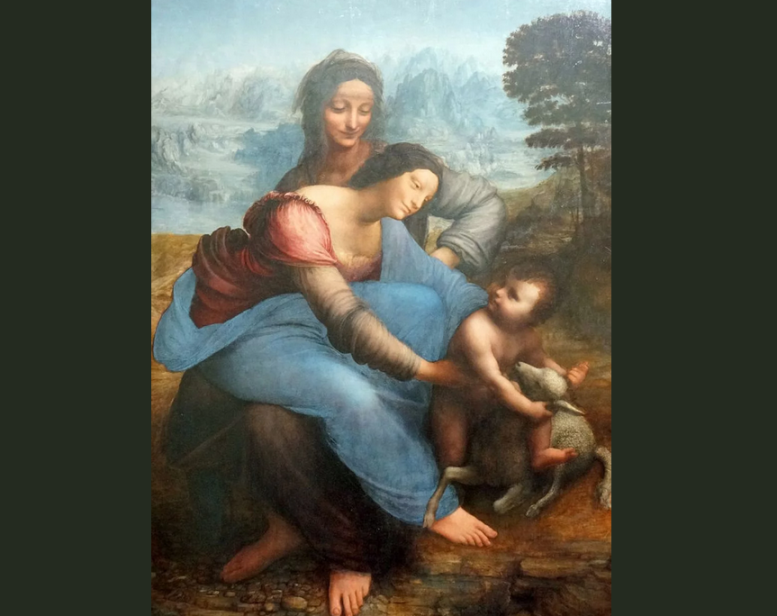
The composition is quite interesting. Anna sitting on the knees of her mother, Maria reaches out with her hands to the baby, and the lamb in this case, perhaps, is a symbol of meekness and sacrifice for sins. Description of the artist’s picture Leonardo da Vinci "St. Anna with Madonna and Baby":
- Persons of all three participants in the action are expressive. They have a mysterious smile typical of da Vinci. It is especially well visible with Anna.
- It is amazing that the artist departs from the usual canons and portrays St. Anna not an elderly sailor, but a young and attractive woman.
- She barely restrains her glee at the sight of a newborn Jesus.
- The lamb is evidence that in the future Jesus will become the Lamb of God will become those who will accept the sins of all mankind.
The landscape is handed over. The family trio looks realistic and pacifying.
"John the Baptist": characteristics of the picture Leonardo da Vinci
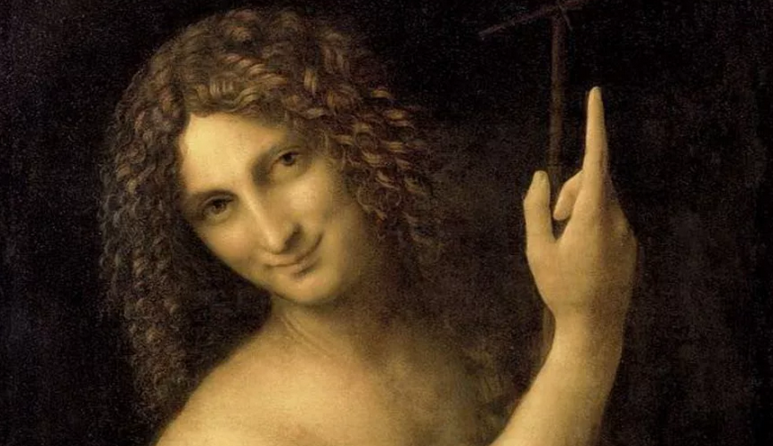
The picture is written at the dawn of creativity. It depicts salai. This is one of the apprentices, a beloved student, to whom the master forgave everything. Here is a characteristic of the picture Leonardo da Vinci "John the Baptist":
- The young man's face is somewhat wife -like - curls are carefully curled.
- The smile with which the young man is looking at is somewhat playful. This suggests what the relationship between the apprentice and the painter could be.
- It is noteworthy that Leonardo could not finish this canvas for a long time. He constantly finished it - he made more and more adjustments, mixed the colors, trying to achieve the perfect result.
- A winning smoky effect is observed. John the Baptist himself is as if shrouded in darkness. But at the same time, his image is sweet and bright, he exudes good and peace.
- You can even say that in his soul there is an internal radiance.
- The artist, as before, professes an excellent game of light and shadow.
- It is noteworthy that the source of golden radiance is very difficult - it seems that it comes from outside - and, perhaps, from the soul of John himself.
The young man raises his finger up, as if by teaching someone. And, perhaps, he just flirts with the viewer. At least his boyish, funny face inspires incredible kindness and location. The image is noticeable, attractive and light.
How much is one picture of Leonardo da Vinci?
Many people are concerned about the question: how much is one painting by Leonardo da Vinci? Everyone knows that this is fabulous money, but what exactly is the amount - you can only guess.
"Savior of the world" - The only picture of the genius that is in private possessions and is available for sale and purchase. However, not every person can afford it. After all, there is a masterpiece - 450 million dollars. Therefore, the “Savior of the world” may well be considered the most expensive picture of the planet. And this is without the slightest exaggeration.
By the way, the unknown collector bought it for 400 million dollars, and the remaining 50 million. Compiled various kinds of commissions and auction fees.
Video: 5 secrets of the famous paintings by Leonardo da Vinci!
Read on the topic:






